| Abanderada | Mexican term describing the pattern formed from the sedimentary or banded build-up of colour horizon which gives a banded or flag-strip effect.
This layered or ‘stripey’ growth pattern notably occurs in Queensland Boulder Opal. The sphere-settling process during opal formation produces the ‘barry’ or ‘ribbon’ colour arrangement, commonly seen in Boulder Opal, as the spheres settle parallel to the ground surface. |
|
| Agitator | A modified cement mixer situated at a ‘tailings’ dam. Water is pumped in to wash the level or Opal dirt whilst it rotates inside. Sludge pores from the mesh covered openings on the sides of the mixer as the load reduces. What remains are the ‘tailings’ which are then picked over looking for potch and colour, hopefully precious opal. | |
| Alluvial | Opal found at or near the surface of the ground in the build up of sediments (alluvium) which have eroded out of the sandstone mesas and deposited in the flats below. Considered by many miners to be the hardest and most stable Opal. | |
| Amber | An Opal type with moderate to strong amber colour potch. Also referred to as ‘beer-bottle’. | |
| Andamooka Matrix | Pale matrix which can sometimes be treated to appear like Black Opal. | |
| Angelstone | A hard highly silicified sandstone lump or nodule (with potch in the shrinkage cracks), it is usually associated with pockets of nobbies in Lightning Ridge and pockets of shells may occur under them in Coober Pedy. Hard semi-spherical or lenticular pieces of (diatomaceous) porcellanite also called walnut stones or by a term first used at White Cliffs – “guardian angel stone”. | |
| Anticline | Folded formation in which the rock stratum dips away from the crest or ridge horizon, i.e. the beds form an arch. A formation turning in the opposite direction is called a syncline. | |
| Asteria | Aka. Asteria Harlequin. This rare and amazing pattern formation shows elongated colour units radiating outwards from a central nucleus, giving the likeness to a star. | |
| Aquiclude | Rock unit which is not permeable to water. | |
| Ballroom | A large underground chamber or open area of worked ground. | |
| Band | A hard siliceous band of sandstone either at the base of a sandstone stratum, or floating within a clay level. It is usually bleached or stained brown and often carries opal beneath it. | |
| Bar | A solid piece of Opal colour running through potch, a very good specimen being a centimeter or so thick. Also refers to an establishment where the Opal miner can usually be found when not mining. | |
| Baroque | Any irregular or abstract shape. Non symmetrical in nature, having both convex and concave outlines. | |
| Barry | Bars of potch found alternating with bars of precious Opal in the seam or nobby. | |
| Belemnite | 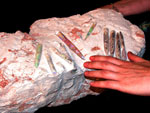 An extinct member of the mollusk family known as cephalopodae, whose living relatives include squid and cuttlefish. Rare fossils of these cretaceous sea creatures have been replaced with gem Opal. Fossil belemnites are the internal shells of the marine invertebrates, they are tapered, cylindrical tubes and mostly hollow at one end. An extinct member of the mollusk family known as cephalopodae, whose living relatives include squid and cuttlefish. Rare fossils of these cretaceous sea creatures have been replaced with gem Opal. Fossil belemnites are the internal shells of the marine invertebrates, they are tapered, cylindrical tubes and mostly hollow at one end. |
|
| Biscuit Band | A flakey, crumbly sandstone, either found cropping out on the surface or quite shallow. Essentially these are alluvial deposits of silt and stone washed out from nearby hills. Most miners consider that they consist of slides of Opal dirt. They may be 10-15cm or more in thickness and appear to go down into levels of opal dirt. They may contain good Opal. In some places they are even found penetrating into black soil. | |
| Black-Crystal | Opal type which is partly transparent from some angles of view. From other angles a rich royal blue flash appears making the Opal opaque and appearing like Black Opal from those angles. | |
| Black Line | This term relates to Boulder Opal where sometimes one side of the opal vein within the host sedimentary ironstone has a layer of manganese or black potch between the opal and the ironstone. This layer is jet black in colour and greatly enhances the appearance of a boulder opal. Most Boulder has a very dark brown face appearance but if the black line is present it will be black and is clearly visible when the opal is viewed edge on. The finest gem Boulder Opal has this black line under the colour and may be termed Black Boulder Opal. | |
| Black Opal | Opal type pertaining to Opal that is dark in colour. Some are black in their own right, others with transparent faces have a black back. The natural black potch backing is the main criterion for the term Black Opal. | |
| Black Boulder Opal | Black Boulder Opal has a thin layer of black potch between the Opal and the ironstone matrix, with no visible ironstone in the face of the stone, making it indistinguishable from Black Opal apart from its natural ironstone backing. Native to Queensland, Boulder Opal comes in 3 base colours; white, brown and black. However most Boulder Opals have ironstone showing on the face as inclusions or the brown ironstone backing is visible through the clear Opal top, only a small percentage of gem grade Queensland Opal can be classified as Black Boulder Opal. | |
| Block Out | To section an Opal in the lapidary process by sawing mostly. Particularly a Queensland boulder concretion into its main Opal bearing parts. The blocking process is usually accompanied by or followed with further exposure of the rock by splitting and facing. Also a term used to describe the division of an area of Opal dirt for systematic removal. | |
| Blocky | Ground which is dark-coloured (reddish), crumbly, iron-stained type of opal dirt which comes away in large blocks. | |
| Blow | A blow is where high pressure moisture builds up in a weak spot in the ground such as an existing fault. This results in the clay being mixed and churned even to the point where the pieces may be rounded from rubbing, one against the other. Blows can be small, varying from alarm thickness to 2 or 3 meters across. most blows will be forced vertically through the clay and will sometimes stop when they strike a roof of sandstone. However, if the blow is strong enough, it will go right through the sandstone to the surface where it can be recognised by hard broken up sandstone and opal dirt mixed together. The blow therefore can usually be identified on the surface by comparison with the surrounding area.
Some miners use the term to refer to well weathered sandstone or mudstone appearing on the surface. Others restrict it to where it appears that chunks of sandstone were ‘blown’ to the surface through the deeper layers. Below ground evidence in support of this can be seen in the nature of sandstone chunks mixed with Opal dirt and other rocks and penetrating all layers. Opal often forms in the vicinity of blows. |
|
| Blower | 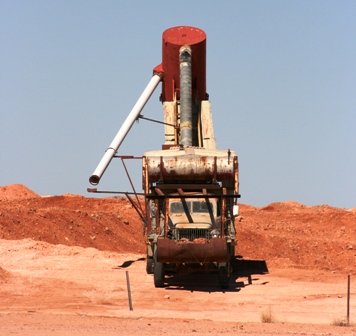 A machine developed at Coober Pedy to extract mullock from underground. Resembling a huge vacuum cleaner in operation. It sucks out the dirt from the underground mine before blowing it out the back end into a hopper which then dumps the dirt on the surface. A machine developed at Coober Pedy to extract mullock from underground. Resembling a huge vacuum cleaner in operation. It sucks out the dirt from the underground mine before blowing it out the back end into a hopper which then dumps the dirt on the surface. |
|
| Blue Opal |  Peruvian blue Opal is an opaque, pastel blue gemstone. This monochrome Opaline material does not exhibit the play-of-colour which characterises precious opals. Peruvian blue Opal is an opaque, pastel blue gemstone. This monochrome Opaline material does not exhibit the play-of-colour which characterises precious opals. |
|
| Bluebottle | Transparent blue potch found mainly in association with Queensland boulder Opal. | |
| Bodgie | The name given to the level closest to the surface. Under this is the squibby, then the main, then the bottom level. Mainly a South Australian term, it is also known as ‘top’ level at Lightning Ridge, followed by ‘second’ until bottom is reached. | |
| Bony Potch | Mainly a South Australian term pertaining to white powdery potch so named because it is said to represent the bony remains of marine creatures. Like thin Opal and potch generally it is only referred to as a trace. | |
| Bottom On | To dig a hole either by hand or machine and hit Opal at the bottom. | |
| Bottomed | Having reached the first level (or bottom level) of Opal dirt after sinking a shaft which has usually passed through layers of sandstone and hard band. Bottom is also used to describe the lowest of several levels (known as bodgie, bottom & main in that order). | |
| Boulder | Mainly pertaining to Queensland Opal occurring in thin veins through, or facing on, hard grey or brown ironstone boulders, which may be very small like an almond or up to 10 meters long and nearly half a metre thick. The Opal can occur between the layers of rocky material which is built up something like an onion, or in pipes, nuts, or kernels, depending largely on the type of boulder structure in the area. | |
| Box Tree | Key geological factors associated with opal formation are the numerous lineaments (representing faults or joints). Throughout the Lightning Ridge Opal Fields the main faulting directions may be expressed at the surface by a number of large Box or Belah trees. | |
| Brick-Pipe | Cylindrically shaped section up to about 2 meters in length, filled with siliceous clayey material in which common Opal is found ramified in all directions. | |
| Brilliance | A general feature of gems, determined in Opal by the intensity of light emerging, the presence of potch, colour and its type and proportion, and the amount of ‘milkiness’ in the Opal. | |
| Broken Level | Where there is no definite roof. The Opal dirt is jumbled up with sandstone. When the Opal dirt is not continous or interspersed with sandstone. | |
| Bug-Hole | Holes usually caused by air, but also used loosely to refer to sand-holes, which interfere with the complete formation of Opal. | |
| Bummy | Usually refers to a Black or Boulder Opal with a very thick back which increases weight and should reduce the per carat price if not the overall stone value. | |
| Burnt | Usually in the expression ‘burnt rock’, when the material is showing only minute Opal traces and has been ‘beaten’ by matrix in the case of seam and nobbies or dry empty voids in Queensland boulders. | |
| Buyer | Specialist opal wholesalers who travel to (or lives in) the opal fields specifically to buy opal. | |
| Cabochon | The most common form of gem cutting, in which the stone is cut with a flat bottom and a rounded top or ‘high domed’ face in cut Opal. | |
| Candle-Box | Poor Opal not really good enough for sale as quality gems. It was stored in candle-boxes at White Cliffs which produced prolific amounts of the stuff. It was sold for as little as £1 per box, Opal Miner, 25 July, 1903. This enabled the development of stockpiles overseas which facilitated its mass machine production and helped popularize Opal around the turn of the century. See Potch-box trade. | |
| Cap Rock | Consolidated near-surface geology. | |
| Carat | A troy Metric measurement for weighing gemstones. One carat equals 0.2 grams (5carats=1gram). | |
| Cat’s-Eye Opal | 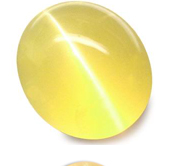 A variety of chatoyant yellow Opaline material, without play of colour, discovered in the state of Bahia, Brazil around 1990. A variety of chatoyant yellow Opaline material, without play of colour, discovered in the state of Bahia, Brazil around 1990.
Sometimes precious Opal stones with a rolling flash pattern are also described as such. |
|
| Chaff | Pattern type with the appearance of straw sprinkled on the Opal surface, each grain of straw with lineal striations. | |
| Chinese-Writing | Pattern type showing one or more shapes which look like Chinese symbols. | |
| Chisel-Pick | A small specially made Opal miner’s pick with chisel points at both ends of the head. See Gouging-pick. | |
| Chips | Small segments of Opal. | |
| Chipping Opal | Snipping the edge of rough to display colour and clarity. | |
| Chrysoprase | 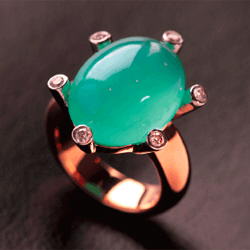 This apple-green to emerald-green Opaline material is found as large seams and nodules mostly in Australia, Africa & Brazil. Cryptocrystalline quartz mineralogically associated with nickel which is responsible for the stone’s colour; it does not display play-of-colour like precious Opal. This apple-green to emerald-green Opaline material is found as large seams and nodules mostly in Australia, Africa & Brazil. Cryptocrystalline quartz mineralogically associated with nickel which is responsible for the stone’s colour; it does not display play-of-colour like precious Opal. |
|
| Church Window | Aka. Cathdral Window, this pattern is observed in woody Boulder Opal whereby geometric segments of opal are partitioned by or framed with ironstone such as to resemble stained glass windows. | |
| Claim Jumping | Applying to the Mines Warden to obtain another miner’s claim, usually for not renewing it or fulfilling the conditions of the lease, which may include working it. | |
| Class | To grade the Opal into firsts, seconds and thirds according to quality. A term from South Australia where Opal is generally sold rough and as parcels of numerous ounces. During a rush the finds can run into thousands of ounces of Opal. | |
| Cloud | A film sometimes found affecting the brilliance of an Opal. Usually matrix or ‘scum’ this will usually grind away during the lapidary process, however if the cloud goes right through the colour it may be potch and cannot be removed. | |
| Cloverleaf | A pattern usually observed in small stones, wherein units of colour form a clover leaf design, by having a central grain/unit/particle surrounded by a ring of outer units. | |
| Collar | That part of the band or hard sandstone roof through which the shaft breaks into the Opal dirt. It varies] from 1 centimetre to half a meter, averaging about 10 cm. Also pertains to the timber framework placed around the top of the shaft. Sometimes there is an outer and inner collar separated by dirt for extra strength. | |
| Colour | The spectral colours which play in precious Opal or the several potch colours. The difference being that potch is flat like paint, and does not radiate light as does the colour in precious opal. | |
| Colour Bar | 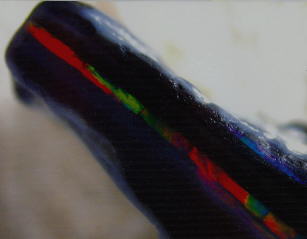 A layer of precious Opal sandwiched between potch or on top of potch. Also applies to a vein of precious opal in boulder or nut type Opal. Two or more horizontal parallel bars of colour may be running through a piece of Opal. A layer of precious Opal sandwiched between potch or on top of potch. Also applies to a vein of precious opal in boulder or nut type Opal. Two or more horizontal parallel bars of colour may be running through a piece of Opal. |
|
| Cotton | Thread-like impurity in opal resembling cotton. | |
| Commercial Quality | Attractive, affordable or lower quality Opal. | |
| Common Opal | Generally called potch,does not display the phenomenon known as play of colour. May be found in various body tones from black to white and lemon yellow, orange, red green or sky blue. Not precious, as it is not very translucent and has no play of colour. However some are not common at all and are increasingly being used for ornamental purposes. | |
| Concrete | In Andamooka this refers to the conglomerate band at the kopi-mud interface, which is the main host rock for opal. In Queensland this may refer to ‘Fairystone’ aka Colour-Concrete which is opalised sandstone(Quartzite) akin to Andamooka Matrix but generally more porous. | |
| Concretion | From Latin: con, together; cretus, grown) Mass of mineral matter formed around some central body by the agency of water; common, in nodular form, in clay ironstone beds. | |
| Conglomerate | 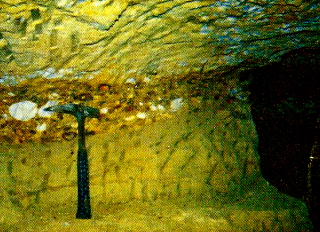 Also referred to by miners as ‘Puddingstone’, is a rock made up of pebbles and other rocks such as ironstone that are a quarter of an inch around or bigger. The concrete at Andamooka is a conglomerate. At Koroit and Yowah nuts are often found in a conglomerate band. Also referred to by miners as ‘Puddingstone’, is a rock made up of pebbles and other rocks such as ironstone that are a quarter of an inch around or bigger. The concrete at Andamooka is a conglomerate. At Koroit and Yowah nuts are often found in a conglomerate band. |
|
| Craze | Opal with a high water content and considerable impurities may have a tendency to crack profusely in a web-like pattern usually not long after it is cut and polished. | |
| Crockery Caps | Found on some nobbies, they consist of white potch Chinese hats on top of the nobby. They are a sign of good Opal if the bottom of the nobby consists of black or opaque blue potch. | |
| Crystal Opal | Opal type, semi-transparent and semi-translucent without milkiness and exhibiting a moderate to rich play of colour. It is superior to jelly,but inferior to semi-black and black-crystal that contain richer colour play. | |
| Cutter | A professional lapidary specializing in Opal cutting and polishing. | |
| Datum Post | The nearest reference point fixed by the Mines Department from which a claim’s boundary are measured. The advent of handheld GPS has lessened their importance. | |
| Deep-Country | In contrast to shallow country, an area in which there might be a half a meter of soil and gravel, then up to 5m of hardened claystone and shincracker, up to 23m of sandstone, then band up to 25cm. Below this is the first level of 1m or so of clay and Opal dirt. Below this there might be successive layers of 1m or so of sandstone and thicker levels of Opal dirt. | |
| Dealer | Specialist Opal wholesaler. | |
| Dip | The inclination or angle at which strata slope or dip downward into the earth. | |
| Digital Terrrain Model | A listing of coordinates representing ground positions and their associated altitudes relative to a common datum, from which the shape of the ground surface can be derived. | |
| Digger | 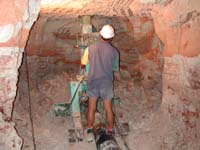 A Machine designed for Lightning Ridge underground mining. It resembles a small excavator which swoops down on the mining face with a multi-pronged head. Essentially this contraption replaces the tiring hand held jackhammer. A Machine designed for Lightning Ridge underground mining. It resembles a small excavator which swoops down on the mining face with a multi-pronged head. Essentially this contraption replaces the tiring hand held jackhammer.
Also a New Zealand and Australian slang term for soldiers. Derived in WWI as ANZAC troops were especially good at digging tunnels between their own trenches and the enemy’s. It is a compliment to be referred to as ‘digger’, because it indicates you are good at a very difficult job, whether you’re a miner or a battler ‘dig’! |
|
| Dobbing Stick | Opals and gemstones are stuck on to such sticks for cutting. The stone is either glued on or lapidary wax is used, once dopped the stone can be more easily manoeuvred. | |
| Dog Stones | Lumps of sandstone hanging down just below the roof (~10cm). Like Angel Stone, except without potch or colour in it, regarded as a good sign. | |
| Dome | The sandstone roof of an underground mine may be shaped like the inside of a dome. Opal tends to occur in the levels beneath this. | |
| Doublet | Manufactured stone with a single slice of translucent Opal adhered to an artificial back of either ironstone (referred to as Boulder doublets), black potch or black plastic. | |
| Drive |  An underground tunnel, leading from a shaft or ballroom. An underground tunnel, leading from a shaft or ballroom. |
|
| Dry Level | Also known as false level, usually the first level from the surface, dry in appearance and non-productive. | |
| Duffer | A shaft sunk on mixed level or a mine which produces no opal. | |
| Dugout | 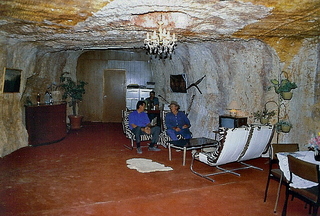 A Miner’s residence dug into the side of a hill. Provides excellent insulation from the extremes of the desert climate. A Miner’s residence dug into the side of a hill. Provides excellent insulation from the extremes of the desert climate. |
|
| Dump | The mullock and dirt heaped up near a shaft, or around and at the end of an open cut. These are often screened or prospected for odd pieces of Opal which have been missed. | |
| Exploding Flash | Rare mobile pattern which appears to explode in all directions as the stone is moved. | |
| Eye-of-Opal | Occurs when opal in fills a cavity or bug-hole which has the effect of looking like an eye because of circles of colour around it. ‘The Flame Queen’ found in Lightning Ridge displayed this most unusual colour pattern; it can be described as having the appearance of a fried egg. | |
| Face | 1. The top side (crown) of an Opal.
2. The wall of a mine in the direction where the miner is headed in expectation of finding opal. The working end of a drive. |
|
| Facing | Or to ‘face up’ as applied to stones, to clean up, grind away any dirt etc. from the stone so as to reveal the appearance of the colour and pattern for sale. Not all stones ‘face’ or show colour when looked at from any angle, some stones only show full colour from one, sometimes, oblique angle. | |
| False Level | A clay level just above the main level where it is not expected to be. | |
| False Bedding | Sedimentary strata in which laminae show irregualrity, being inclined to each other at various angles. Common in shore-line, estuarine, and windblown deposits. Commonly called current bedding. | |
| Fault | Fracture resulting from earth movement. Gems may form in the material of a fault or slide (Lightning Ridge) or opaliferous material may fill a slide (South Australia). In most Opal bearing country there is a primary fault structure followed by or setting up a series of slides and slips. | |
| Fern | Pattern type also called ‘tree pinfire’. | |
| Ferruginous | Containing iron, as in iron rich sediments. | |
| Fire | A term used to describe a lively Opal with good play of colour. Often but not always with vivid red predominant. | |
| Fiery | A term used to describe any Opal with a dominant red hue in the colour play. Sometimes the term ‘red Opal’ is used. | |
| Fire Opal | Correctly applied to Mexican Opal of volcanic origin with a red-orange body tone. Some times used to describe red play of colour. ‘Fire’ is sometimes used as a precursor and is a synonym for precious Opal or the ‘play of colour’ phenomenon. | |
| Firsts | A South Australian word for opal of top quality also referred to as the ‘tops’. In Lightning Ridge better known as gems. | |
| Flag Harlequin | Resembling a 3 cornered flagstone paving. See also Fishscale Harlequin. | |
| Flagstone | Opal pattern with numerous irregular colours resembling flagstones in their arrangement. | |
| Flame Opal | The name used to describe an Opal when mainly red flashes cover the entire surface of the stone. | |
| Flame Pattern | Colours are arranged in a more-or-less regularly streaked effect (rather than in stripes as in Abanderada). Flash of Fire is another term to describe the same effect. The stone may need to be turned to a certain angle before the colours resemble the dancing flames from a log. | |
| Flash | Pertaining to Opals whose light shows a single flash in a large patch of colour. It may move in one or several directions. This pattern can be sub divided into Rolling-Flash, Flash-fire, Exploding Flash and Broken Flash. | |
| Floater | When common or precious opal pieces, nobbies, seams, pipes, nuts, matrix or fragments of boulder opal are eroded out of their original host rock and found in creeks and as lag material in gullies or on scree slopes close to mesas or escarpments. Also called ‘Top Show’. | |
| Floor | The bottom of a drive or tunnel. | |
| Floral | Opal pattern type with rounded irregular grains of colour, larger than pinfire and having the appearance of a floral design. | |
| Fossicker | One who digs unsystematically or only in a small way, usually covering ground worked by others. | |
| Foul Air | Stale air in which, due to a lack of ventilation in the mine, poisonous gases can build up. | |
| Free Form | A piece of Opal where the natural shape of the stone has been retained when cutting, often to avoid wasting weight for the sake of a popular shape. | |
| Full-Colour | Colours clear to see and obviously good, especially when evident without viewing from special angles. | |
| Fun Stone | 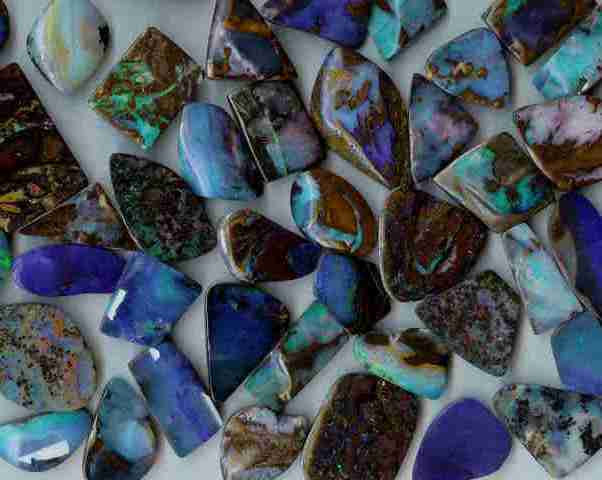 Low to medium grade, Boulder Opal in particular, where potch, ironstone and scene-like inclusions are retained in the cut and polished piece. Similar to ‘F#%@ Stones’ given away by eager miners to attractive lady visitors. Low to medium grade, Boulder Opal in particular, where potch, ironstone and scene-like inclusions are retained in the cut and polished piece. Similar to ‘F#%@ Stones’ given away by eager miners to attractive lady visitors. |
|
| Gad | A long hand-held steel chisel for drilling holes in hard ground for explosives, by tapping with a hammer. Used extensively by the ‘Old timers’. | |
| Gem | Pertaining to quality, the best or highest quality stones of any Opal variety | |
| Gemmy | Aka. Gem, Opal of top quality for use in distinctive jewellery. | |
| Geo-Hammer | Or Geologists pick, different from that required for Opal gouging, but reasonably good for splitting smaller boulders. | |
| Gibber | Rounded wind polished pebbles or cobbles of silcrete, quartzite and ironstone, forming a surface layer or pavement. Characteristically reddish-brown owing to a concentration of iron oxides on the surface. | |
| Gidgea | 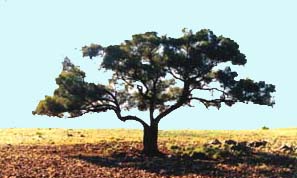 A tough outback species of native tree, Acacia cambagei, also known as ‘stinking wattle’ as it emits a pungent scent particularly when rain is imminent. Gidgea trees generally line watercourses on stony gibber plains. A tough outback species of native tree, Acacia cambagei, also known as ‘stinking wattle’ as it emits a pungent scent particularly when rain is imminent. Gidgea trees generally line watercourses on stony gibber plains. |
|
| Ginger Whisker | An inclusion in white Opal rough from Coober Pedy. Rust Coloured marks in opal often associated with cracks. A form of cracking which results in right angular cubes breaking away from the stone when it is cut. | |
| Gouge | When the miner is digging out opal, prying it loose from the Opal dirt, or digging with a pick in anticipation of striking it. | |
| Grain | This may refer to pattern as seen on the face of an opal or the particles, units or patches of colour which make up the stones overall pattern. | |
| Grass | Pattern type similar to straw pattern but with thinner units and lineal striations. | |
| Gray | White or grayish Opal often found in match box sized pieces in Coober Pedy. Usually quite opaque until it is sliced very thinly to produce triplets and mosaics. | |
| Greasy-back | A section in and above the Opal dirt which may fall in. It is usually caused by penetrating water making the sandstone greasy and likely to slip away. Also a term referring to oldtimers. | |
| Greybilly | A dense, massive silcrete generally grey to greenish grey or creamy coloured. Also referred to as Shincracker this highly silicified rock is found towards the surface at certain fields particularly in Coober Pedy and Lightning Ridge. | |
| Gun Claim | A term used to describe a rich claim or the top claim in a field. | |
| Gun Stone | Used by miners and dealers to describe an exceptional gem quality Opal. | |
| Gypsum | A mineral commonly found in association with Opal on all the fields. Either as sheets or small to large clusters. Also an inclusion in Opals of all types, which takes the form of fine capillary like threads within an Opal. It resembles spider web in colour and form and is termed web or webbing by miners and dealers. | |
| Harlequin | 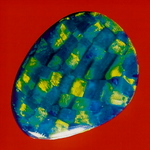 The most desirable pattern in Opal. The most desirable pattern in Opal.
Strictly applies to Precious Opal colour play in an arrangement of chequerboard squares. More broadly used to describe a regular mosaic-like pattern of blocky, angular, roughly square patches of about equal and relatively large size. This type can be subdivided into Asteria Harlequin, Square Harlequin, Chequerboard Harlequin, Fishscale, Cloverleaf, Flag Harlequin and Hexagonal Harlequin. The term originates from the spangled costume worn by the harlequin clowns. ‘Harlequin’ is a term reserved for the description of only the liveliest of Opals, it may be used as a adjunct eg. Floral Harlequin when a Floral pattern is exceptionally large and playful. |
|
| Hyalite | A glassy, colourless and transparent form of common Opal that has formed as crusts. | |
| Hydrophane | ||
| Iris Pattern | A sheeny pattern. Irisation which appears as colour sheen in opal. | |
| Ironstone Band | Is found in some areas adherent to the bottom of the sandstone in sheet form. This hardened layer can be a significant continous level, producing matrix and some exceptional stones can be cut from fine veins of colour | |
| Jasper | Hard tough, silicified grey shiny rock boulders or layers. | |
| Jelly | A type of Light Opal with almost transparent body tone, may perhaps have a slight blue, yellow, green or reddish hue. The play of colour may range from weak to precious. | |
| Jeweller’s shop | The name given to a rich find. | |
| Kernel | Opal inside a kernel boulder. | |
| King-stone | Also a Queen stone or Topstone, a superior stone which stands out in a patch or pocket. | |
| Kopi | Grey, silty, clay-like sandstone or fine-grained gypsum. | |
| Lapidary | A cutter, polisher, carver or engraver of precious stones. | |
| Lead | Opal with good colours but having a dull leaden finish. Opal with a slightly translucent grey back and may be suspect as far a stability, cracking etc. are concerned. | |
| Level | 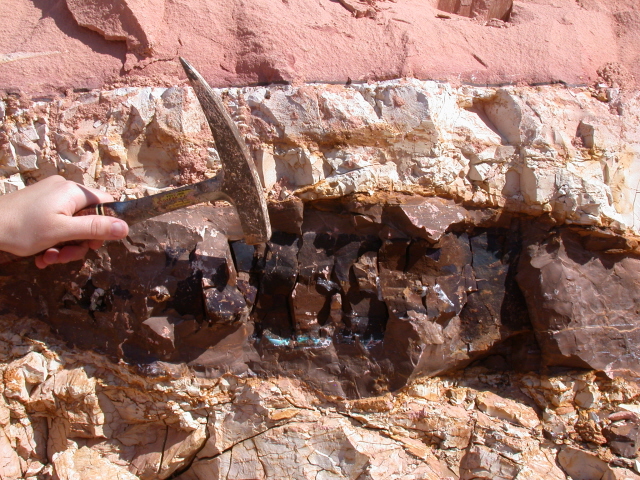 A more or less horizontal intersection, usually clay below sandstone, which may or may not be productive for Opal. A more or less horizontal intersection, usually clay below sandstone, which may or may not be productive for Opal.
Within the Opal profile, generally no deeper than 30 meters, numerous levels occur. One or two are usually productive levels, however some rare systems may show up to 10 levels with 5 or 6 of them producing some colour. |
|
| Lineament | A structurally-controlled linear topographic feature of regional extent. | |
| Londoner | A shaft which breaks through into a drive of someone else’s claim workings. | |
| Looks at you | Said of a good stone when good colour is seen from any angle. | |
| Main Level | This term is usually restricted to the level that happens to carry the most Opal. | |
| Mackerel Sky | Aka. Ribbon Pattern, is a type of Rolling Flash. All the spectral colours may be present in this form, which can be likened to a sunset, with clouds broken into long, thin parallel masses. | |
| Make | To form, develop into, be present. Thus some potch ‘makes’ into gem Opal. When the level makes Opal, the miner has struck a deposit of Opal. | |
| Matrix | 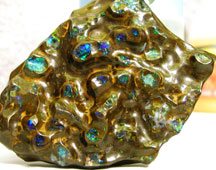 Where there are only small flecks and veinlets of precious Opal in opaque matrix. Used to describe flecks or veins of colour in quartzite (Andamooka matrix/Fairystone) or ironstone (Boulder matrix). Where there are only small flecks and veinlets of precious Opal in opaque matrix. Used to describe flecks or veins of colour in quartzite (Andamooka matrix/Fairystone) or ironstone (Boulder matrix).
Miners ar Lightning Ridge use this term to describe a porous white or greyish impurity in black opal. Sometimes also referred to as scum. |
|
| Matrix-lines | Lines of matrix material which appear between grains of colour in the face of an Opal, and are the cause of cracking. Sometimes confused with potch-lines which do not cause surface cracks. | |
| Mesa |  Flat top ranges or hills. Flat top ranges or hills. |
|
| Milky | Or ‘Milk Opal’ is the white variety which displays subdued pinfire effects and patchy colour. Usually refers to milk white opaque to slightly translucent Opal. Milkiness is a quality which detracts from brilliance and sharpness in the play of colour of an Opal. Also referred to in Mexican Opal specimens as Lechosos. | |
| Miner | Anyone professionally mining opal. | |
| Monkey | Refers to a shaft which is sunk underground in a drive to gain entry to a lower level. It does not go directly up to the surface. A shaft intersecting two opal dirt levels or a tunnel following a slide. | |
| Mother-o’-Opal | Another name for matrix, especially a kind of Opalised sandstone material found in Queensland and Andamooka (concrete) containing streaks of colour. This material is coarser and more porous than Andamooka matrix. | |
| Mud Boulder | Fine grained ironstone boulders containing thin cracks which may carry good quality dark Opal. | |
| Mud Level | Non productive clay level. The last clay level, usually deep and moist, the miner does not expect Opal to occur beyond this depth. | |
| Mugstone | Or ‘muggy’ is a Lightning Ridge term for low grade Opal. Generally refers to stones below commercial grade.
The term came about in the early days of the Lightning Ridge Opal field when buyers would not purchase low quality Opal so the miners put them in a large enamel mug until tourists came to town. As they were not experienced in Opal, they purchased them at what they thought were bargain prices. Nowadays many of these Opals would be worth good money. |
|
| Mulga |  A native wattle tree, Acacia aneura, which covers a large proportion of the Australian semi-arid savanna or shrubland. The species has a long life and extremely hard wood. A native wattle tree, Acacia aneura, which covers a large proportion of the Australian semi-arid savanna or shrubland. The species has a long life and extremely hard wood. |
|
| Mullock | Opal dirt that has been dug up and removed, then dumped around the shafts or pushed out of open-cuts. | |
| Multicoloured | A stone that has more than 3 colours in it, but may have one colour dominating. | |
| Multifire | A stone which has lots of colours without any particular colour dominating. | |
| Natural Joint | In seams or fossils when 2 or more pieces, from a pocket, fit neatly together (like a jigsaw puzzle) in the ground. | |
| Nest | A collection of Queensland boulders, particularly kernels or Yowah nut type stones occurring as a pocket. | |
| Nigger head | Hard spherical masses of fine-grained silica ranging up to fifty or more kilos in weight. Also used to refer to a gem quality nodule of dark hued, brilliant opal as found on the old Nine Mile field at Coober Pedy. | |
| Night Stone | Any Opal of such high quality that it has brilliant colour even in dim light, and especially under artificial illumination. | |
| Nobby | 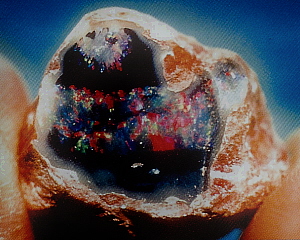 A rounded opal nodule or concretion found in clay, particularly at Lightning Ridge. Nobbies occur in varying sizes but all a similar shape believed to be fossil plant bulbs. A rounded opal nodule or concretion found in clay, particularly at Lightning Ridge. Nobbies occur in varying sizes but all a similar shape believed to be fossil plant bulbs. |
|
| Noble Opal | An old term for precious Opal. Noble is a qualifyng term used generally in mineralogy to express fineness and superiority. | |
| Nodule | Rounded or ovaloid concretions generally harder than their host rocks. Nobbies and Yowah nuts are nodules. | |
| Noodling | Looking for Opal in mullock heaps and open cuts. | |
| Old Man Black | Black Opal from the best areas at Lightning Ridge which has a coal black potch with a faint blue tint. Very rare these days as most areas of origin are worked out. | |
| Opal Dirt | A common name to describe sandstone, shale and clay levels which carry Opal. Usually a soft white clay band in which veinlets and nodular masses of Opal occur. | |
| Opalite | Used to refer to a plastic opal simulant. Also used as another name for Volcanic Opal aka. Mountain Opal, as distinct from sedimentary Opal found in sandstone. Also can be a Cinnabar coloured banded material aka. Myrickite. | |
| Opal Fever | An addiction, once found Opal enters the blood stream, a good miner never gives up! | |
| Opal Field | A mining area that has several working and/or historic mines and has been named and recorded by the mines department as a field. Opal fields are divided into large districts such as Coober Pedy, Winton, Lightning Ridge. then they are subdivided into smaller areas such as 8mile, Opalton, Coocran. Generally these sub-fields are less than 10 square kilometers and no less than 1km square. | |
| Opalessence | Properly used this denotes a pearly shimmer often shown by common Opal. It is caused by the scattering of light. It can also be observed in moonstone, chrysoberyl and opal glass. | |
| Open | To cut open a piece rough opal or split a boulder. To determine where the best colour lies so that the most attractive jewel can be made. | |
| Orange Tree | Eremocitrus glauca, the desert lime or native Australian orange tree, Aka. limebush or native cumquat, this species was the ‘wild lime’ featured in the Australian cookbook of the same name. The botanical name of this species is derived from eremos, the Greek word for ‘desert’ and glauca, meaning ‘bluish’, referring to the blue-grey colour of the leaves. The natural distribution of this species is the semi-arid regions of eastern Australia, from Rockhampton to Longreach in Queensland, south to Dubbo in central New South Wales and west to Quorn, in the FlindersRanges of South Australia.
Opal miners in Queesland consider it an excellent indicator for Opal where it usually grows along faults that may carry or set up Opal. The tree varies in size and form, from a dense multi-stemmed thicket of 2-3m in height, to a taller, more upright tree of 12m. The fruit is round to oblate in shape and approximately 2cm in diameter, weighing from 1-3g. The skin is a light yellow-green on maturity and contains large oil glands. The flower to fruiting time is the shortest of any citrus species, being from 10-12 weeks mainly in spring and fruits ripen in summer.The acidic fruit is often seedless and can be used whole in cooking.op |
|
| Outcrop | That part of a stratum which appears at the surface. | |
| Painted Lady | A boulder, generally of quartzite (concrete), which splits along a fracture to reveal a thin coating of Opal, these are found at Andamooka. In Queensland ironstone boulders of this ilk are termed splits or specimens. | |
| Palette Harlequin | A pattern with widely spaced units, similar to the layout of colours on an artist’s palette. | |
| Palaeochannel | Sandstone bodies associated with known Opal deposits; Palaeochannels are filled with sedimentary deposits which are unrelated to the normal bed load of the current drainage pattern. Palaeochannels may be arranged on old drainage patterns distinct from the current drainage system of a catchment. Eg.A system of rivers and creeks which drained east-west may be overlayed by a current drainage direction which is north-south. These broad erosional channels into a basement which underlies a system of depositional sequences may contain several episodes of deposition and represent meandering peneplain streams. | |
| Pancake | This type of ironstone concretion is highly prized by miners in Queensland. Generally shaped like a discus, they are dense and fine-grained rocks, of a chocolate brown colour. 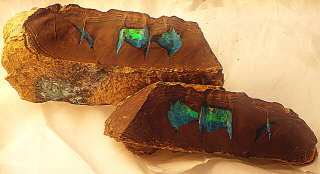 They carry gem Opal, in the form of thin and powerful colour bars. They carry gem Opal, in the form of thin and powerful colour bars. |
|
| Parcel | Numerous pieces of Opal offered for sale as one lot. This may be rough or cut and usually constitutes one type of Opal from a pocket or patch; or a period of the miner’s production. | |
| Patch | An Opal occurence consisting of a series of rich pockets forming one after another, generally coming from one lead. | |
| Pattern | The arrangement of grains of colour as they appear in a stone. Patterns which display larger grains are rarer and more valuable than smaller patterns. | |
| Pea Opal | A small stone about the size and shape of a dried pea. Rough pea nobbies are found at lightning Ridge and levels of very similar shaped stones have been recorded in Coober Pedy. | |
| Pegs | Used in ‘pegging’ a claim, this can be done with 1 or more wooden or metal stakes, usually four are used. The laws in each state govern the exact regulations and claim dimensions allowed. | |
| Pennyweight | Used to measure the weight of rough Opal. Equal to 1/20 of a Troy ounce and approximately 1.555 grams. | |
| Picture Stone | Opals which display a picture with their pattern, sometimes in conjunction with inclusions or structure lines, that reminds us of a specific object. Whereas most patterns are often repeated, picture stones are rare and more unique. Picture stones are given names which reflect the specific images they portray. | |
| Pigeon’s blood | The name for the deepest coloured red Opals. The miners describe red colour as ‘ox blood’, ‘pigeon blood’, ‘port wine’ red and so on down to ‘rose pink’. | |
| Pillar | When underground mining if wide drives are made pillars of untouched dirt must be left as roof props to ensure safety from a potential collapse. | |
| Pincers | Used to clip off the edge of a rough seam or nobby to see if good Opal is underneath. Usually called Snips and also referred to as nippers. | |
| Pineapples | 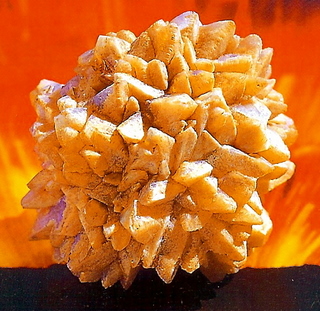 These pseudomorphs are Opal replacements of glauberite or ikaite crystals. They resemble miniature pineapples and are found exclusively at White Cliffs NSW. These pseudomorphs are Opal replacements of glauberite or ikaite crystals. They resemble miniature pineapples and are found exclusively at White Cliffs NSW. |
|
| Pinecones | Opalised cones, stem and root fragments of primitive pine and cycad-like plants are common in Lightning Ridge. Mostly small varieties ranging from 10-30mm, there are various species. Usually compressed and slightly flattened, their scales are a diamond or half-moon shape. | |
| Pinfire | Aka Pin-point Opal OR Twinkle pattern, is characterised by a mass of minute or pinpoint-sized specks of colour, less than 1mm in diameter. This type can be subdivided into moss, peacock’s tail, tree/fern pinfire. The most outstanding Pinfire radiates the sheen of one colour which changes completely through the spectrum as the stone is viewed from various angles. | |
| Pink Opal |  Mined in the Peruvian Andes this monochromatic pastel pink Opaline material is an opaque gem, without the colour-play usually associated with precious opals. The best quality stones are those without black fern-like inclusions. Mined in the Peruvian Andes this monochromatic pastel pink Opaline material is an opaque gem, without the colour-play usually associated with precious opals. The best quality stones are those without black fern-like inclusions. |
|
| Pipe Opal | Queensland’s Opal fields produce both Pipe Boulder Opal and free Pipe Opal in sandstone.
|
|
| A small concentrated area of Opal. Not more than 2 or 3 meters square. Also referred to as a ‘nest’.
A patch is a larger occurence consisting of a series of rich pockets forming one after another, generally coming from one lead. |
||
| Pot | Old Queensland word for a pocket of opal. | |
| Potch | Common Opal,does not display the phenomenon known as play of colour. May be various body tones, from black through to the grey range, to white then on to glass clear, pale yellow and the full range of browns. | |
| Potchy | Opal with visible potch inclusions in the face. | |
| Potch & Colour | Potch in which patches of precious Opal occur, generally refers to low grade rough suitable for ornaments. | |
| Potch-box trade | The buying up of tones of mainly low grade Opal, for sale overseas. See also Candle-box Opal. | |
| Puddling | 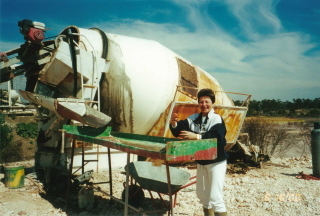 To process Opal dirt for recovery of Opal. In Lightning Ridge today this is most commonly done with the aid of water in an agitator (similar to a concrete mixer)which produces a slurry. The older dry method uses mechanical sieves or rumblers. In South Australia small rumblers are used with water and ‘noodling machines’ are a popular dry processing plant. To process Opal dirt for recovery of Opal. In Lightning Ridge today this is most commonly done with the aid of water in an agitator (similar to a concrete mixer)which produces a slurry. The older dry method uses mechanical sieves or rumblers. In South Australia small rumblers are used with water and ‘noodling machines’ are a popular dry processing plant. |
|
| Puddling tank | A large dam at which wet puddling takes place. Miners rent sites where they operate power-driven wet puddlers capable of handling several tones of dirt in one operation. | |
| Prasopal | A variety of common Opal that is leek green. The name is derived from the Greek prason (leek). | |
| Precious Opal | Opal that has the prismatic play of colour for which the gem is noted. Without changing colours, it is not precious. Precious Opal is not the same as Fire Opal. | |
| Pseudomorph | A mineral which takes the form or shape of another mineral which it has replaced by substitution or by chemical alteration. | |
| Ratter | A thief who works another miner’s claim after hours. | |
| Red coming out of blue | An appearance of this happening with these two spectrum colours as the Opal is moved. | |
| Red on Black | An aspect of the foreground and background colour in which spectrum red colour pattern overlays a backing that is black potch. | |
| Reptile Skin | Opalised reptile skin are rare fossil remains. These display overlapping scales of irregular size and delicate wrinkles. | |
| Rickshaw | A two-wheeled trolley underground miners use instead of a wheelbarrow to convey dirt to the bucket at the shaft. | |
| Rolling-flash | A mobile pattern in which a flash of colour rolls across the stone as it is moved. There may be more than one apparent. Although usually arranged in parallelograms the direction of movement can vary. | |
| Roof | The top of a drive, usually the base of the sandstone where it overlies the Opal level. | |
| Rough | Raw Opal which has been freed of dirt but has not been cut. | |
| Rubs | Opal Rough which has been ground or ‘rubbed’ down to the colour bar. Either done quickly to obtain an idea of the likely quality of the gem or in careful preparation to cut and polish the stone. | |
| Rumbler | A meshed cylindrical drum, of various proportions, mechanised or manually operated, used wet or dry, to sift Opal dirt. | |
| Run | Opal formation tends to ‘run’ in front of a slide for the length of the slide. Opal may occur in all or only one level. Although most of the Opal formed is usually potch and only a little is precious, a run is a more vast (~50m2) deposit than a pocket (>3m2). Also a more consistent level than a patch, a run is most likely to occur on the main level. | |
| Runner | A commission agent employed by the miner or merchant to sell Opal on their behalf, where the source remains anonymous. This term is most commonly applied when the dealings are done at the Opal fields. | |
| Rush | Newly discovered Opal prospect where miners hurry to peg claims. large numbers of miners gathering at a newly discovered or re-opened mineral deposit. | |
| Sand | Patches of sand derived from the host clay or sandstone, as inclusions within or adhering to an Opal. | |
| Sand-pit | A lump of sand in an Opal stone which leaves a sand-hole when removed. These are often minute and need to be treated gently by the lapidary, so they do not become enlarged or the stone ground to oblivion. | |
| Sand-shot | A fault occurring when a stone is marred by sand inclusions, these damage the appearance and value particularly if seen from the face of a gem. Often these appear only upon cutting. They present a challenge to the lapidary and may cause pitting in the surface of the stone. | |
| Sandstone | Opal bearing rocks vary in nature from field to field but are usually a form of desert sandstone. | |
| Sandy Boulder | These boulders are coarser grained and lighter than the denser fine-grained ironstone boulders. Sometimes they are referred to as ‘salt & pepper’ boulders. Usually they are associated with the Quilpie mining district, these boulders occur on different levels across the Queensland Opal fields. They occur in the largest sizes of all boulders, sometimes several meters across. | |
| Scotch Plaid | This pattern refers to agreen-blue effect in black opal displaying brilliant colour combinations. | |
| Scree | The fragments of decomposing rock found at the bottom of cliffs and rises. | |
| Screening | A method of noodling in which a wire screen, bed frame, perforated drum or anything providing a mesh is used to shake out dirt and leave concentrates to be checked for Opal. | |
| Scum | A rare fault which is not apparent in freshly cut stones. With age a film (‘scum’) appears over the surface, resulting in a loss of brilliance. This may be removed by repolishing. | |
| Seam Opal | Narrow seams of precious Opal that has formed in fissures and cracks in the host rock. Formed in more or less horizontal (or vertical) seams varying from paper thin traces to slabs more than 10cm thick. Jelly, milky opal, white opal, grey opal, crystal opal and semi-black opal occur as seams, generally of irregular shape.
|
|
| Sedimentary Opal | In Australia all of the commercially produced Opal is formed in the vast desert sandstones which have undergone extensive weathering. | |
| Semi-Black | An Opal type with stronger concentration of potch colour than crystal and in which the Opal is only just transparent. The Lightning Ridge semi-black is any variation between light and black Opal, it is nearly always very bright, and can be very valuable. | |
| Shallow country | In contrast to deep country, a landform with a meter of soil and gravel to the biscuit band up to 3m thick, followed by possible sandstone up to 1m or more thick over the first dry level of Opal dirt. | |
| Shell | 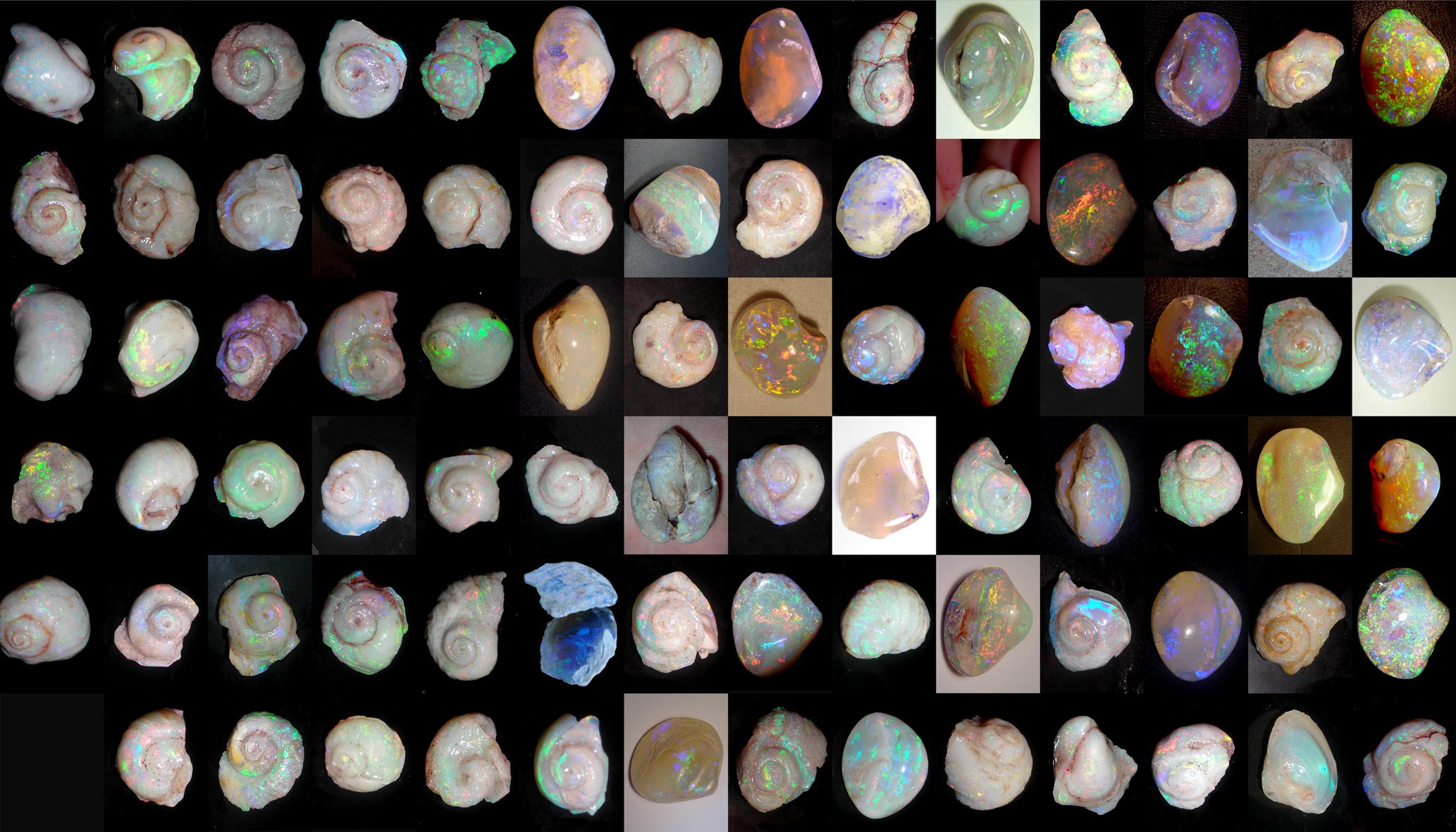
Opalised marine fossils occur as full or partly replaced shells with sandstone cores, varieties include; bi-valves or clams, snail, turritella or whelks and cockles or mussels. |
|
| Shincracker | Also known as silcrete or greybilly this term was applied by hand miners. When they struck the rock with their picks it would shatter and splinters would strike them in the shins. | |
| Show | Or ‘Opal Show’ is a term used by miners to describe an Opal prospect. | |
| Siliceous | Of or portaining to silica. | |
| Silcrete | Any rock cemented (silicified) or replaced by secondary silica. | |
| Sinking pick | A heavy pick used o break up hard top-rock while sinking a shaft by hand. The sinking pick blunts considerably faster than the driving pick. | |
| Skin shell | When entire these look like a solid Opal but only has a thin skin of Opal (probably where the original shell was), and an inside composed of sand. | |
| Slide | 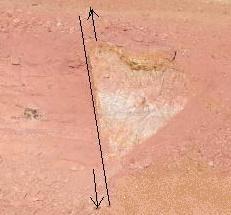 Slippery or Slippery back, any slide on an angle that seperates one level from another. Some call it a slip or a fault. A minor fault. A gritty fault plane is believed to indicate the presence of precious Opal. Slippery or Slippery back, any slide on an angle that seperates one level from another. Some call it a slip or a fault. A minor fault. A gritty fault plane is believed to indicate the presence of precious Opal. |
|
| Slip | A small secondary slide which runs more or less parallel to a major slide and cracks the ground sufficiently to permit the deposition of good Opal. Sometimes called a ‘sleeper’. | |
| Smoky | A translucent type of potch, blackish, sooty in nature, and providing the semi-dark background for the star-flash pattern in precious Opal. May also be used to describe a hazy appearance without clear-cut colours which can lower the value. | |
| Snips | Used to trim of the edges of rough to ascertain quality. An essential tool for the Opal digger, something like a pair of pincers with sharp jaws, used to remove a small section from the edge of a rough seam or nobby. | |
| Solid | Natural formed precious Opal of one piece. | |
| Specking | Searching for Opal missed by the miner on old mullock heaps. | |
| Spider | A piece of heavy gauge fencing wire bent and coiled to hold a candle close to the working face of an underground drive. | |
| Spidery | Descriptive of an anatomising network of fine irregular veins often observed in Queensland Boulder Opal. | |
| Splitting | Or cleaving, a difficult rather secret knack of hitting or shearing a boulder to reveal two faces of Opal. Using a fine chisel and small hammer so that it falls apart according to the crystal growth structure. Freezing is often employed, sometimes followed by hot water immersion and screw drivers used to coerce the stone which has been incised with a blade along the fully exposed Opal vein. | |
| Spotter | A person who walks behind a Bulldozer looking for signs of Opal during excavation. Also referred to as a ‘Checker’, in Queensland they hit the boulders as they come up in the level, to find traces. | |
| Square Harlequin | Squarish disjointed colour units are present in the Opal pattern. | |
| Squibby Level | And ‘bodgie level’ are early sub-levels that occur above the main level, they may make smaller pockets but are not as prominent, continuous or productive. Also may be referred to as ‘false level’. | |
| Star Flash | Type of pattern with a play of colour on semi-translucent smoky potch which gives an effect like stars in a semi-dark sky. | |
| Steel Band | Thin seam of quartzite found above Opal dirt. | |
| Step | A fault in the level where the roof drops suddenly at a right angle for a meter or more, then continues horizontally. Also known as a ‘wall’, such a drop is regarded as a favourable indication. Opal may be found on its high or low side. Steps may be anything from a meter to 100 meters long. | |
| Stow Dirt | Loose dirt which is removed from the face but left underground. Usually stowed in disused drives. | |
| Stratum | (plural: strata) A section of a formation that consists throughout of approximately the same kind of rock material; a stratum may consist of an indefinite number of beds, and a bed may consist of countless layers. | |
| Straw | Type of pattern with the appearance of flat pieces of straw overlapping irregularly. | |
| Strike | Dip and strike should be considered together. The dip is the inclination of a bed measured in degrees from the horizontal. The strike is the direction of the outcropping edge of an inclined bed on a horizontal surface (such as it would be on a flat plain) and is recorded in degrees from north or south. | |
| Structure lines | 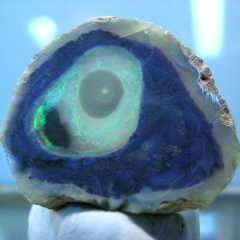 Lines in an Opal where the internal structure of the Opal, the size and/or alignment of the silica spheres, has changed. Not cracks. These often provide the basis for unique designs or patterns as seen in picture stones. Lines in an Opal where the internal structure of the Opal, the size and/or alignment of the silica spheres, has changed. Not cracks. These often provide the basis for unique designs or patterns as seen in picture stones. |
|
| Sunflash | This play of colour is muted and not readily visible unless examined in a strong light source such as full sun or bright spotlights. Sunflash Opal does not have colour bars but resembles jelly or amber potch in which small colour particles are floating. This material is often Dark Opal and the colour is more obvious against a dark background. | |
| Syncline | (Greek: syn, together; klino, I incline) A structure in which the strata dip inward from opposite directions, like the leaves of a half opened book, or which incline to a common centre, forming a trough or basin-shaped hollow. Opal miners, especially in Queensland, refer to significant deposits as ‘basins’ which act as a trap for opal formation, despite considerable erosion of the stratum in the surrounding region. | |
| Tailings | The material which is left over after the miner has sorted through it, by processing a load of Opal dirt in an agitator (wet wash) or dry puddler or in a noodling machine. | |
| Teeth | Encompassing toothplates and jawbone fragments from lungfish, teeth from sharks, crocodiles and dinosaurs have been found Opalised at numerous fields around Lightning Ridge and to a lesser extent in South Australia where plesiosaur remains have been found. | |
| Toe Dirt | As miners gouge the Opal dirt falls at their feet, it is called toe dirt in contrast to the Opal bearing level known as ‘pay’ dirt. | |
| Top Show | Surface trace and/or floaters indicating an area prospective for Opal. | |
| Trace | Thin or small pieces of potch or Opal which pinch in and out and may lead to a pocket. Hopefully! | |
| Treated | Usually in the expression treated Andamooka Matrix, which is a pale porous matrix with little dispersed Opal, but able to be converted to an appearance of solid black Opal by a process of dehydration and treatment with sugar and acid which deposits carbon in the pores. Queensland Boulder or Band Matrix is not the same, it polishes beautifully without treatment. | |
| Tribute | One’s share when working on a partnership basis, that is as a tributer. The owner of the mine is usually a silent partner who does not work at the mine but is paid a percentage of the Opal, the tribute. | |
| Triplet | A manufactured stone made of Opal as a part of three layers. A thin slice of Opal is sandwiched between a black potch or plastic backing and a domed quartz or plastic capping is adhered to the face to act as protection and a magnifier. | |
| Troy Ounce | (Ozt) is a unit of imperial measure. It is still most commonly used to gauge the weight of precious gems and metals. There are 20 penny weights to a troy ounce or 155 carats.
1 troy ounce = 31.1034768 grams |
|
| Tucker Money | A parcel of Opal which puts food (known as ‘tucker’ to the bushman) on the table and if you’re lucky some fuel in the tank! To get ‘beer money’ the miner needs a good find or the Publican’s still buying!! | |
| Tumbling | The simplest form of gem cutting, in which the rough mineral is put into a revolving barrel with progressively finer abrasives, until a polish is obtained. This process closely resembles what happens to rocks in a stream, except that it results in a higher level of polish. | |
| Tunneling Machine | 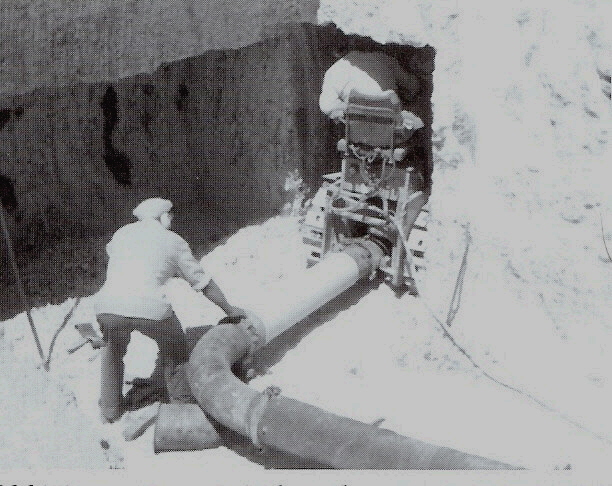 A machine which coupled to a blower can carve out drives and ballrooms including underground dwellings, particularly well suited to working the hard and stable sandstones of Coober Pedy. A machine which coupled to a blower can carve out drives and ballrooms including underground dwellings, particularly well suited to working the hard and stable sandstones of Coober Pedy. |
|
| Turkey’s nest | A mess at the bottom of a shaft as a result of collapsing dirt, timber etc. | |
| Twinkle | Pattern of small separated star-like colours, rather like a scattered ‘Pinfire’. | |
| Vertebra | Fossilised bones are not uncommon on the Opal fields the largest and most recognizable of which are vertebrae replaced by Opal. Opalised dinosaur bones have been found at white Cliffs and South Australia, Lightning Ridge has also produced numerous specimens belonging to fish, turtles, crocodiles, pterosaurs, theropods and sauropods. | |
| Vertical Opal | A seam of Opal which is found in situ laying at a vertical angle as opposed to the more common horizontal formation. Vertical Opal will only face on its thinnest sides as the lamellar patterns run across the stone instead of along it. | |
| Verticals | A vertical structure of clay several centimeters wide, usually in sandstone or Opal dirt. Verticals provide a conduit for water entering from above to form Opal below. Also known as ‘feeders’. Vertical seams represent cracks or faults in the sandstone which may also be refered to by miners as ‘blows’. | |
| Volcanic Opal | Opal which has deposited in former volcanic areas and in association with volcanic rock. Believed to contain a high percentage of moisture. Aka. Mountain Opal | |
| Wood Opal | 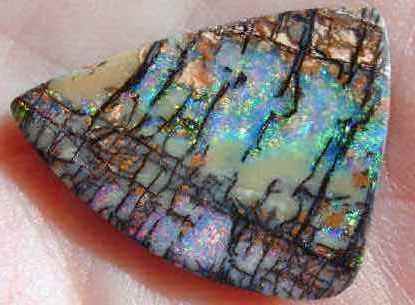 Wood that has been replaced by Opal. Also referred to as ‘wood replacement’. Wood that has been replaced by Opal. Also referred to as ‘wood replacement’. |
|
| Webbing | A fault which can grow somewhat like a spider web. It tends to follow pattern lines. In some cases this may be removed by repolishing, however it will invariably reoccur with the overall effect being loss of brilliance. | |
| Windsel | A device to ventilate mines. A tube made of cloth or canvas is fed into the shaft, the mouth of the exposed tube is then faced into the breeze at the top of the shaft. | |
| White Opal | Opal type also known as Light Opal, has a body tone ranging from milky white to translucent. The most common variety found at most fields and mainly at Coober Pedy in South Australia. White Opal, with its lighter to whitish body colour, gives the full colour array in an opaque background. | |
| White Horse | A blow which has been bleached white by the leaching effect of ground moisture rising. Because of this intensive leaching, siliceous sediments caused the blow material to harden. | |
| Windlass | A hand winch for hauling up dirt out of the mine shaft. | |
| Yabby buttons | Opalised crayfish gastroliths. Known as ‘fish-eyes’ to the miners at Lightning Ridge where they are common throughout the fields. They range from a few millimeters up to 20mm in diameter, indicating yabbies up to 300mm in length. | |
| Yapunyah | Ghost Gum tree native to semi-arid Queensland found atop rocky mesas growing on faults and fractures from whence they get moisture and nutrients. | |
| Yowah Nut | 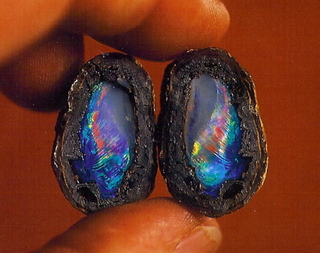 An ironstone concretion which may be the size of an almond up to an Emu egg, containing a solid Opal kernel or an Opal Matrix inside. An ironstone concretion which may be the size of an almond up to an Emu egg, containing a solid Opal kernel or an Opal Matrix inside. |
|
Volcanic Opal Miner’s Vocabulary |
||
| Abanderada | Mexican term describing the pattern formed from the sedimentary or banded build-up of colour horizon which gives a banded or flag-strip effect. | |
| Cachalong | Opaque and bluish white resembling porcelain, this Opal is porous and will absorb water quickly. | |
| Cherry Opal | Cherry red ground colour. Occasionally has play of colour. | |
| Contra Luz | Opal, usually from Mexico, which shows its best colours against the light. | |
| Fire Opal | Translucent Mexican Opal with red or orange overall colour. Not synonymous with precious opal. If the red Opal has play of colour, it is precious fire Opal. | |
| Girasol | Aka. Water Opal, is clear (nearly transparent) Opal with a bluish floating light reflected from the depth of the stone. This precious form of Opal may display various floating colours. | |
| Honey Opal | Pale Amber-coloured Opal, usually with play of colour. | |
| Hydrophane | Dehydrated Opal that appears opaque and lifeless until it is immersed in water and slowly becomes more translucent until, in some cases, it becomes totally transparent and shows play of colour. Most commonly volcanic in origin, from Indonesia or Mexico. | |
| Lloviznando | A Mexican term which literally means ‘drizzling’, it is used to describe a pattern which appears like ‘sunlight filtering through rain’. | |
| Lechosos | Milk Opal or Milky Opal. with play of colour against a pure white ground colour. | |
| Mountain Opal | Aka Volcanic Opal | |
| Pintas | Small specks of Precious Opal. | |
| Tablon | Table-like or tabletop mountain. | |
Imitation & Synthetic Opal Terms |
||
| Dragon’s Breath | Dragon’s Breath is the name given to a rare and highly collected man-made glass stone that was used in jewelry making around the early 1900’s and most of the settings are 925 sterling.
‘Dragon’s Breath’ aka; Mexican Glass Opal, Glass Jelly Opal, or Glass Fire Opal; not to be confused with foiled glass. Dragon’s Breath was made by adding metal to the molten glass. This gives it electric blue and purple flashes or ripples inside the stone. Usually seen in an oval or round cabochon shape. The stone is transparent and un-foiled. The colors have a mixture of orange, red, yellow, and sometimes even a rose tint. Then depending on the angle that you view it, there is an inner fire of beautiful streaks of electric blues and purples that seem to just levitate inside the glass. At some angles you can see more of the blues and purples. Other angles you may see only small amounts and again at other angles you may see none. This blue and purple “breath” inside the red orange glass is what gave the stone it’s name. |
|
| Foiled Glass |
|
|
| Paua | Aka. ‘Ariki’ ( a brand of imitation Opals). Paua Shell finished as cabochons resembling Opals. | |
| Slocum Stone | A glass Opal simulant that appears to contain small tinsellike flakes of laminated material. Made by John L. Slocum in the late 1970’s. Slocum took the formula to his grave.
Slocum Stone appears to be a layered glass which displays various different base colours and fire patterns. Very hard and much more durable, it does not appear to be affected by extreme heating like opal. The color display tends to look transparent and somewhat patchy, colour is never continuous thoughout the stone and shows strong zoning. The top layer is very clear and resembles the top of an opal-triplet or doublet. The bottom of the stone is also clear but darker in complexion. All of the colour flash is localized into the contact zone between these two layers. The colouring agent may be a metal oxide, or even a glass dye which has been added, and then sealed into the stone with the addition of a top. |
|
| Tabasheer | A hard, whitish, translucent substance exracted from the joints of bamboo. Consiting of pure silica, this Opal-like herbaceous gem is highly valued in the East for medicinal purposes. |
Sources & Image Credits:
A JOURNEY WITH COLOUR Vol II Part A, Len Cram, 1998.
A FIELD GUIDE TO AUSTRALIAN OPAL, Barry O’Leary, 1977 (patterns)
A GUIDE TO PRECIOUS OPAL, Douglas M.Stone & Robert A.Butt, 1976.
AN OPAL TERMINOLOGY, J.S. Gunn, 1971.
AUSTRALIAN PRECIOUS OPAL, Archie Kalokerinos, 1971.
BLACK OPAL FOSSILS OF LIGHTNING RIDGE, Elizabeth & Robert Smith, 1999.
LAPIDARY JOURNAL, Article: Opal in the US by June Culp Zeitner, June 1986.
OPAL – THE PHENOMENAL GEMSTONE, 2007.
OPALINE, Miners & Merchants of Opal (various photos of mining & gems)
REDISCOVER OPALS IN AUSTRALIA, Stephen Aracic, 1999.
THE SMART CHART, Peter Evans, 2005.
Opal Mining at Lightning Ridge, John McCabe, 1979.
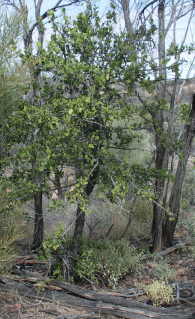 The desert lime is the only pronounced xerophyte in the orange subfamily, extremely drought tolerant and able to withstand extremes of hot (45ºC) or cold (-24ºC) temperatures. In its natural habitat of inland woodlands and brigalow scrubs, it is found growing on a wide range of soil types.
The desert lime is the only pronounced xerophyte in the orange subfamily, extremely drought tolerant and able to withstand extremes of hot (45ºC) or cold (-24ºC) temperatures. In its natural habitat of inland woodlands and brigalow scrubs, it is found growing on a wide range of soil types.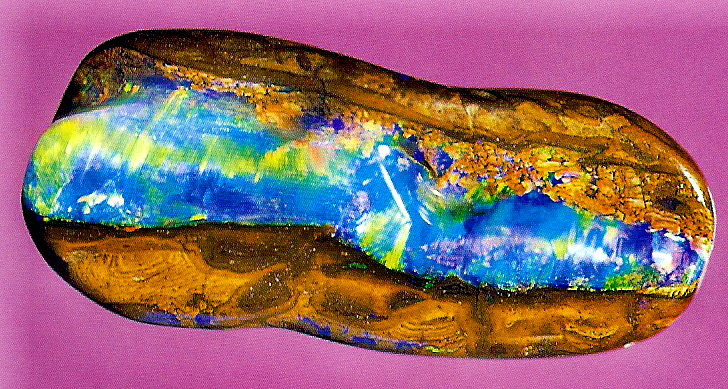 It may be several inches thick and a foot long. The free pipes are found in or below the hardened layer or
It may be several inches thick and a foot long. The free pipes are found in or below the hardened layer or